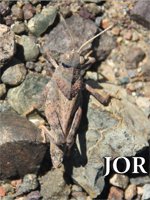The semiaquatic grasshopper Cornops aquaticum Bruner, which is highly specific of Eichhornia crassipes (Pontederiaceae), constitutes one of the most abundant herbivores in the Neotropical wetlands and a possible biological control agent of this weed in South Africa. The aims of this study were 1) to assess the performance of each age category of C. aquaticum on crop plants and the host plant E. crassipes; 2) to assess the feeding preference of this grasshopper on crop plants in the presence and absence of E. crassipes; and 3) to determine the presence of nymphs and adults of this grasshopper on crops and in the adjacent wetlands where Eichhornia plants are present. Crop plants included in this study were Zea mays, Oryza sativa, Saccharum officinarum and Ilex paraguariensis. The age categories of C. aquaticum population were nymphs A (instar I and II), nymphs B (instar III to VI) and adults (females and males). To assess grasshopper performance on E. crassipes and crop plants, survival and oviposition were recorded during the no-choice tests. To evaluate feeding preference, choice tests with crop plants in the presence and absence of E. crassipes were performed. Abundance of C. aquaticum in the crop patches and the wetlands vegetation was assessed using an entomological net. During the no-choice tests, high survival of most C. aquaticum individuals was observed on Z. mays and E. crassipes, except for nymphs A fed on Z. mays. Ovipositions were registered in E. crassipes, Z. mays and S. officinarum, but only eggs laid in E. crassipes were endophytic and viable. C. aquaticum showed high preference to E. crassipes, whereas Z. mays and S. officinarum were the preferred plants in the choice test without E. crassipes. We did not find C. aquaticum individuals in the crop patches of Z. mays, O. sativa and S. officinarum, whereas abundance of this grasshopper varied between 28 and 62 individuals captured per minute on Eichhornia floating meadows near these cultivated areas. Our results confirm the high specificity of C. aquaticum to E. crassipes because eggs laid on crop plants are not viable and nymphs A have no possibilities of surviving when fed on these plants. Finally, we recommend carrying out choice tests and field samplings throughout the whole native range of C. aquaticum.
How to translate text using browser tools
1 December 2014
Performance and Feeding Preference of Cornops aquaticum (Orthoptera: Acrididae) on Eichhornia crassipes and Crop Plants in Native Area
Celeste Franceschini,
F. Solange Martínez,
M. Laura De Wysiecki
<
Previous Article
|

Journal of Orthoptera Research
Vol. 23 • No. 2
December 2014
Vol. 23 • No. 2
December 2014
host-specificity
Leptysminae
semi-aquatic grasshopper
water hyacinth




